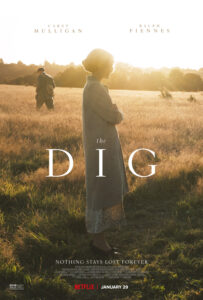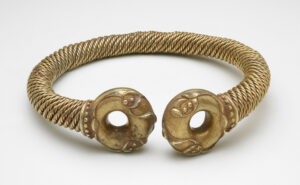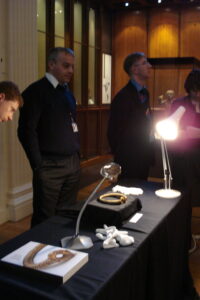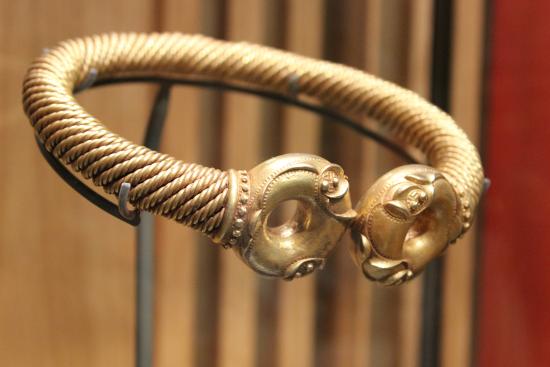Newark’s extraordinary discovery: a closer look at the Newark Torc
 Netflix’s recent archaeological hit The Dig has reminded us of the hidden history beneath our feet. The enthralling story of discovery reminded me of Newark’s own re-discovered treasure – The Newark Torc.
Netflix’s recent archaeological hit The Dig has reminded us of the hidden history beneath our feet. The enthralling story of discovery reminded me of Newark’s own re-discovered treasure – The Newark Torc.
The Dig dramatises Basil Brown’s excavation of the Sutton Hoo – an oak burial ship accompanied by a wealth of Anglo-Saxon artefacts – and its coincidence with World War Two. The treasure discovered, from as far away as the Byzantine Empire, revolutionised thinking about the Anglo-Saxon world. Nowadays it is considered to be the most significant archaeological find in the UK.
Over 60 years after Basil Brown unearthed the first traces of the Sutton Hoo, metal detectorist Maurice Richardson was searching for treasure in the fields surrounding Newark. He recalls it was a ‘horrible wet afternoon in February’ in which he uncovered piece after piece of scrap. However, Maurice soon came across a relic from another world – a torc of plaited gold.
Maurice’s discovery was dated to between 200 and 50 BC – Iron Age Britain, when Celtic tribes populated the land (just before the Romans arrived, and several hundred years before the Sutton Hoo was buried).
Torcs were neck-rings present in cultures around the world; in Celtic society they were often traded or given as a gift between tribes. Research suggests that this particular Torc was created by a member of the Iceni, the Norfolk-based tribe later led in rebellion against the Romans by the warrior queen Boudicca.

Interestingly, only 200 Celtic Torcs have been unearthed in Britain, mostly in Norfolk. To find something like this in Newark was unheard of, and prompted many to wonder – how did it get there?
The answer could lie further north. Pieces of a Torc discovered in Netherurd, Scotland, bore remarkable similarities to Maurice’s, leading archaeologists to wonder whether they were created by the same person. If this is the case, the Newark Torc could revolutionise our idea of how Iron Age people manufactured such precious objects. Torc production may not have been exclusive to the Iceni but could have spread West and North!
Experts believe it was buried deliberately. Rivers such as the Trent were important to Celtic people; a lot of metal work from this era has been found close to rivers. Although who it was buried by, and for what purpose, remains a mystery.
One thing can be certain though – the Newark Torc is an extraordinary artefact. Research reveals it is made from gold, silver and copper. During the Iron Age gold came from Wales, Ireland, Spain and Turkey, suggesting the creator of the Torc had connections beyond the boundaries of their own territory. Scans of the object reveal almost 45 metres of gold wiring entwined into 8 ropes. The ‘terminals’ at either end of the rope were decorated in ‘La Tene’ style, a European style first discovered in Switzerland.

The Newark Torc on display at the British Museum
Due to its stunning design and completeness, the Newark Torc is considered one of the best of its kind to be discovered. Maurice’s find was so significant that it – mirroring the Sutton Hoo – was displayed in the British Museum. It remained there until 2015, when it was purchased back and put on display in Newark’s Civil War Centre.
A key theme of The Dig is how people’s legacies continue in what they leave behind. Like the Sutton Hoo, the Newark Torc is the handprint of a long-gone generation. While the Celtic people and their settlements have disappeared, the presence of the Newark Torc allows us to learn about them, from their craftsmanship to their connections. As spoken by Carey Mulligan’s character Edith Pretty, by preserving it we become ‘emissaries from another world’.
The Newark Torc can be seen in the National Civil War Centre in Newark. The museum remains closed during the national lockdown. However if you’re interested in learning more about our past, follow the link below to the museum’s ‘Learning From Home’ resource:
https://www.nationalcivilwarcentre.com/learningfromhome/
The Newark Torc can be seen featured on this page as a Star Object:
https://www.nationalcivilwarcentre.com/starobjects/#d.en.117226
Alternatively, follow this link for a chance to watch Maurice Richardson’s re-telling of how he first came across the Torc:
https://www.youtube.com/watch?v=Zg0wz8vA37Q
Written by Will Parkinson, Economic Growth and Tourism Apprentice.
